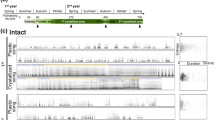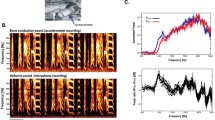Abstract
Among avian species that communicate using vocalization, songbirds (oscine Passeriformes), hummingbirds (Trochiliformes), and parrots (Psittaciformes) are vocal learners. Early studies showed that songbirds require auditory feedback for song development in young and maintenance in adults. To determine whether auditory feedback is also necessary for adult song maintenance in non-passerine species, we deprived adult male budgerigars (Psittaciformes) of auditory input by surgical cochlear removal. Songs of the deafened birds changed within 6 months after auditory deprivation. In postoperative songs, high narrowband syllables, which comprised frequency-modulated narrowband elements with relatively high fundamental frequencies of 2–4 kHz, decreased significantly. High harmonic broadband syllables, with fundamental frequencies ≥2 kHz, also decreased. The altered proportions of syllables were subsequently retained, and maintained 12 months after deafening. The sequence linearity score, a parameter representing the stereotypy of the syllable sequence, was higher than that before deafening. The inter-syllable silence was prolonged. Little change was observed in the songs of intact and sham-operated birds. The significant decrease in high-frequency syllables and song alteration followed by stabilization resembled the results with songbirds, although song stabilization took a long time in budgerigars. Therefore, our results suggest that psittacine budgerigars and oscine songbirds require auditory feedback similarly for adult song maintenance.







Similar content being viewed by others
References
Bottjer SW, Arnold AP (1982) Afferent neurons in the hypoglossal nerve of the zebra finch (Poephila guttata): Localization with horseradish peroxidase. J Comp Neurol 210:190–197
Bottjer SW, Arnold AP (1984) The role of feedback from the vocal organ. I. Maintenance of stereotypical vocalizations by adult zebra finches. J Neurosci 4:2387–2396
Brauth SE, Heaton JT, Durand SE, Liang W, Hall WS (1994) Functional anatomy of forebrain auditory pathways in the budgerigar (Melopsittacus undulatus). Brain Behav Evol 44:210–233
Brockway BF (1964) Ethological studies of the budgerigar: reproductive behavior. Behaviour 23:294–324
Cynx J, von Rad U (2001) Immediate and transitory effects of delayed auditory feedback on bird song production. Anim Behav 62:305–312
Dooling RJ (1986) Perception of vocal signals by budgerigars (Melopsittacus undulatus). Exp Biol 45:195–218
Eda-Fujiwara H, Okumura H (1992) The temporal pattern of vocalizations in the budgerigar (Melopsittacus undulatus). J Yamashina Inst Ornithol 24:18–31
Eda-Fujiwara H, Watanabe A, Okumura H (1995) Effects of deafening on temporal pattern of vocalizations in the budgerigar Melopsittacus undulatus. J Ethol 13:145–152
Eda-Fujiwara H, Kinoshita M, Okumura H (1997) Response of the telencephalic neurons of the budgerigar Melopsittacus undulatus to species-specific warble song elements. Zool Sci 14:13–19
Farabaugh SM, Wild JM (1997) Reciprocal connections between primary and secondary auditory pathways in the telencephalon of the budgerigar (Melopsittacus undulatus). Brain Res 747:18–25
Farabaugh SM, Brown ED, Dooling RJ (1992) Analysis of warble song of the budgerigar Melopsittacus undulatus. Bioacoustics 4:111–130
Farabaugh SM, Linzenbold A, Dooling RJ (1994) Vocal Plasticity in budgerigars (Melopsittacus undulatus): evidence for social factors in the learning of contact calls. J Comp Psychol 108:81–92
Gahr M (2000) Neural song control system of hummingbirds: comparison to swifts, vocal learning (songbirds) and nonlearning (suboscines) passerines, and vocal learning (budgerigars) and nonlearning (dove, owl, gull, quail, chicken) nonpasserines. J Comp Neurol 426:182–196
Heaton JT, Brauth SE (1999) Effects of deafening on the development of nestling and juvenile vocalizations in budgerigars (Melopsittacus undulatus). J Comp Psychol 113:314–320
Heaton JT, Dooling RJ, Farabaugh SM (1999) Effects of deafening on the calls and warble song of adult budgerigars (Melopsittacus undulatus). J Acoust Soc Am 105:2010–2019
Jarvis ED, Mello CV (2000) Molecular mapping of brain areas involved in parrot vocal communication. J Comp Neurol 419:1–31
Konishi M (1963) The role of auditory feedback in the vocal behavior of the domestic fowl. Z Tierpsychol 20:349–367
Konishi M (1965) The role of auditory feedback in the control of vocalization in the white-crowned sparrow. Z Tierpsychol 22:770–783
Kroodsma DE, Konishi M (1991) A suboscine bird (eastern phoebe, Sayornis phoebe) develops normal song without auditory feedback. Anim Behav 42:477–487
Leonardo A, Konishi M (1999) Decrystallization of adult birdsong by perturbation of auditory feedback. Nature 399:466–470
Marler P, Waser MS (1977) Role of auditory feedback in canary song development. J Comp Physiol Psychol 91:8–16
Nordeen KW, Nordeen EJ (1992) Auditory feedback is necessary for the maintenance of stereotyped song in adult zebra finches. Behav Neural Biol 57:58–66
Nottebohm F (1968) Auditory experience and song development in the chaffinch Fringilla coelebs. Ibis 110:549–568
Nottebohm F (1971) Neural lateralization of vocal control in a passerine bird: I. Song. J Exp Zool 177:229–262
Nottebohm F (1972) The origins of vocal learning. Am Nat 106:116–140
Nottebohm F, Nottebohm ME (1976) Left hypoglossal dominance in the control of canary and white-crowned sparrow song. J Comp Physiol 108:171–192
Nottebohm F, Nottebohm ME (1978) Relationship between song repertoire and age in the canary Serinus canarius. Z Tierpsychol 46:298–305
Nottebohm F, Stokes TM, Leonard CM (1976) Central control of song in the canary, Serinus canarius. J Comp Neurol 165:457–486
Okanoya K, Yoneda T (1995) Effect of tracheosyringeal nerve section on sexually dimorphic distance calls in Bengalese finches (Lonchura striata var. domestica). Zool Sci 12:801–805
Okanoya K, Yamaguchi A (1997) Adult Bengalese finches (Lonchura striata var. domestica) require real-time auditory feedback to produce normal song syntax. J Neurobiol 33:343–356
Price PH (1979) Developmental determinants of structure in zebra finch song. J Comp Physiol Psychol 93:260–277
Scharff C, Nottebohm F (1991) A comparative study of the behavioral deficits following lesions of various parts of the zebra finch song system: Implications for vocal learning. J Neurosci 11:2896–2913
Schwartzkopff J (1949) Über den Zusammenhang von Gehör und Vibrationssinn bei Vögeln. Experientia 15:159–161
Sibley CG, Ahlquist JE (1991) Phylogeny and classification of birds. Yale University Press, New Haven
Striedter GF (1994) The vocal control pathways in budgerigars differ from those in songbirds. J Comp Neurol 343:35–56
Striedter GF, Freibott L, Hile AG, Burley NT (2003) For whom the male calls: an effect of audience on contact call rate and repertoire in budgerigars, Melopsittacus undulatus. Anim Behav 65:875–882
Suthers RA (1999) The motor basis of vocal performance in songbirds. In: Hauser MD, Konishi M (eds) The design of animal communication. MIT Press, Cambridge, pp 37–62
von Békésy G (1959) Similarities between hearing and skin sensations. Psychol Rev 66:1–22
von Gierke HE, Oestreicher HL, Franke EK, Parrack HO, von Wittern WW (1952) Physics of vibrations in living tissues. J Appl Physiol 4:886–900
Watanabe A, Aoki K (1998) The role of auditory feedback in the maintenance of song in adult male Bengalese finches Lonchura striata var. domestica. Zool Sci 15:837–841
Watanabe A, Sakaguchi H, Hessler NA (2005) Effects of deafening on song pattern of adult male zebra finches: a direct comparison with Bengalese finches. Zool Sci 22:1513
Watanabe A, Li R, Kimura T, Sakaguchi H (2006) Lesions of an avian forebrain nucleus prevent changes in protein kinase C levels associated with deafening-induced vocal plasticity in adult songbirds. Eur J Neurosci 23:2447–2457
Williams H, Crane LA, Hale TK, Esposito MA, Nottebohm F (1992) Right-side dominance for song control in the zebra finch. J Neurobiol 23:1006–1020
Woolley SMN, Rubel EW (1997) Bengalese finches Lonchura striata domestica depend upon auditory feedback for the maintenance of adult song. J Neurosci 17:6380–6390
Wyndham E (1980) Diurnal cycle, behaviour and social organization of the Budgerigar Melopsittacus undulatus. Emu 80:25–33
Acknowledgments
This work was supported by the Japan Women’s University Prize for Academic Excellence. We thank Drs. H. Sakaguchi, K. Aoki, R. Li, S. Nagata and R. Imaichi for their helpful comments. Y. Yoshida, Y. Yoshimatsu and N. Nakahara helped us for song analysis, and J. Kushner for improving the manuscript. This experiment was complied with the “Principles of animal care”, publication No. 86–23, revised 1985 of the National Institute of Health.
Author information
Authors and Affiliations
Corresponding author
Rights and permissions
About this article
Cite this article
Watanabe, A., Eda-Fujiwara, H. & Kimura, T. Auditory feedback is necessary for long-term maintenance of high-frequency sound syllables in the song of adult male budgerigars (Melopsittacus undulatus). J Comp Physiol A 193, 81–97 (2007). https://doi.org/10.1007/s00359-006-0173-y
Received:
Revised:
Accepted:
Published:
Issue Date:
DOI: https://doi.org/10.1007/s00359-006-0173-y




